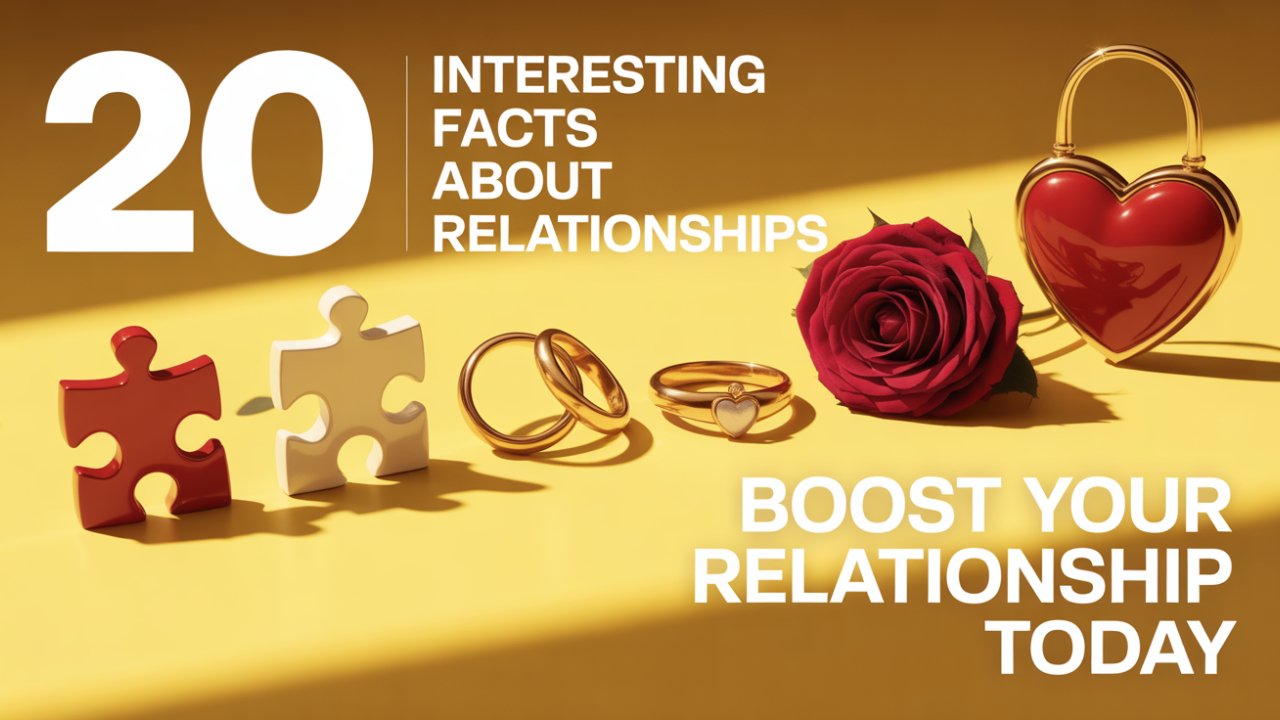You think you know love? Get ready to question everything. We’re about to drop some of the most shocking truths about modern dating, marriage, and attraction you’ve probably never heard before. For instance, did you know that just being head-over-heels in love can actually help dial down physical pain? Stick around as we count down 20 fascinating facts that will change the way you see relationships forever.
Number 1: Men Tend to Fall in Love Faster
Alright, let’s start by busting a myth that everyone seems to believe. Pop culture loves to paint women as the ones who fall hard and fast, while men are shown as commitment-phobic. But science says the opposite is often true! Research shows that men tend to fall in love and say “I love you” more quickly than women. It’s not that their feelings are less real, they just get there faster. Why? Some researchers think men are more visually driven at first, which can spark romantic feelings sooner. Others suggest women are more evolutionarily wired to be cautious, taking more time to size up a partner’s long-term potential before letting their heart take over. So, next time you think he’s dragging his feet, remember—science says he might have been secretly smitten for weeks.
Number 2: Being in Love Can Literally Relieve Pain
You know that feeling when you’re so infatuated that nothing can bring you down? Well, there’s some wild science behind that. Studies have shown that the intense, passionate feelings of a new relationship can have a powerful pain-relieving effect, acting as a sort of natural analgesic. In one study, people experiencing mild pain reported feeling it less intensely just by looking at a picture of their partner. Brain scans showed that seeing their beloved lit up the same reward centers—like the caudate nucleus—that are targeted by pain-dulling medications. This euphoric state releases a flood of dopamine, the feel-good chemical, creating a natural high that can genuinely distract from and reduce the sensation of pain. It gives a whole new meaning to “love is the best medicine,” proving that an emotional connection can bring real, physical comfort.
Number 3: The Online Dating World is Massive and Growing
If it feels like every couple you meet nowadays met online, you’re not wrong. The online dating scene has absolutely exploded, and it’s not slowing down. It’s projected that by 2028, nearly 700 million people will be using dating apps and websites around the globe. In 2024 alone, the industry is set to rake in a mind-blowing $8.1 billion. And this isn’t just a young person’s game. Nearly half of all single Americans who are looking for a partner have tried online dating. Technology has completely rewired how we find romance. It’s shifted from chance encounters at a coffee shop to a deliberate, algorithm-driven hunt for “the one.” The sheer scale of it proves that swiping is no longer the alternative—for millions, it’s the main event.
Number 4: Long-Distance Relationships Can Be Surprisingly Strong
We’ve all heard the warnings about long-distance relationships, right? They’re too hard, they’re lonely, they’re doomed to fail. But the research tells a much more optimistic story. Studies have actually found that long-distance couples often report the same—or sometimes even higher—levels of trust, intimacy, and satisfaction as couples who live in the same city. How is that even possible? It all comes down to communication. When you’re separated by distance, you can’t rely on just being together physically. You have to put in the work with deeper, more meaningful conversations. These couples often idealize their partners more and put more effort into every single interaction, which leads to a stronger bond. So while it’s definitely tough, this proves that love can absolutely conquer mileage.
Number 5: Love Literally Goes Through Phases in Your Brain
That crazy, all-consuming, can’t-think-straight feeling of falling in love? That’s not just you being dramatic—it’s a specific chemical cocktail hitting your brain. Science shows that love actually moves through distinct biological phases. Phase one, or infatuation, is fueled by a rush of dopamine and norepinephrine. That’s what gives you the euphoria and obsessive focus on your new person. At the same time, your serotonin levels drop. Fun fact: low serotonin is also linked to OCD, which explains why you literally can’t stop thinking about them! But that intensity doesn’t last forever. As a relationship matures, the brain chemistry changes. The dopamine rush fades and gets replaced by oxytocin and vasopressin—hormones linked to long-term bonding and security. This is your brain’s way of shifting from passionate, fiery love to the calmer, more stable attachment that makes a partnership last.
Number 6: The Median Age for First Marriage is at a Historic High
For generations, getting married in your early twenties was the norm. Not anymore. Today, that timeline has completely changed. In the United States, the median age for a first marriage has hit an all-time high: 30 for men and 28 for women. That’s a huge leap from 1960, when it was closer to 23 for men and 20 for women. So why is everyone waiting? It’s all about a massive shift in priorities. More people are focusing on getting their education and careers sorted out before they even think about settling down. Plus, it’s now totally normal to live on your own, move in with a partner, and just take your time finding the right person instead of rushing to the altar. The game has changed, and a solid foundation is the new prerequisite for “I do.”
Number 7: For Most People, Love is the Top Reason to Marry
In a world that can feel pretty cynical about marriage, it’s awesome to know what actually motivates people to tie the knot. When you ask Americans why they got married, the number one reason isn’t money, pressure, or even just companionship. It’s love. A massive 88% of Americans say love is the most important reason to get married. That beats out the number two reason, making a lifelong commitment, which 81% of people cited. This shows we’ve moved away from seeing marriage as a practical arrangement and toward viewing it as the ultimate expression of an emotional connection. Despite all the modern-day challenges, the main reason people commit is still that simple, powerful feeling. Romance isn’t dead—it’s the foundation of it all.
Number 8: Cohabitation is a Common Step for Young Adults
Living together before marriage used to be a huge taboo, but today, it’s basically a standard relationship stage. Data shows that about 14% of Americans between 25 and 34 are currently living with an unmarried partner. For many, moving in together is like a “test drive” for marriage—a way to see if you can handle each other’s daily quirks before making it legally binding. For others, it’s just the natural next step in a serious relationship, whether or not marriage is on the table. And for some, living together is the end goal, a fulfilling alternative to a traditional marriage. It’s clear that sharing a lease is no longer just for married couples; it’s a huge part of how modern relationships evolve.
Number 9: Interracial and Interethnic Marriages are on the Rise
One of the most positive changes in modern relationships has been the massive increase in interracial and interethnic marriages. The numbers tell an incredible story. In 2015, a full 17% of all newlyweds in the U.S. married someone from a different race or ethnicity. To give you some perspective, that number was a tiny 3% back in 1967, the year the Supreme Court finally made laws against it unconstitutional. That’s a more than fivefold increase! And younger generations are leading the charge. A recent survey found that 53% of Gen Z and Millennials think more people marrying someone from a different racial background is a good thing for society. It’s proof that in a more connected world, love is increasingly seen as something that beautifully transcends race and ethnicity.
Number 10: Men are More Likely to Remarry Than Women
Ending a marriage is tough on everyone, but some interesting patterns show up when you look at what happens next. Statistically, men are way more likely to remarry than women are. After a divorce or the death of a spouse, about 64% of previously married men will eventually get married again. For women, that number is quite a bit lower, at 52%. What’s behind this remarriage gap? Some experts think men may rely more on their partners for emotional support and managing the household, so they’re more eager to partner up again. Others point out that since men often marry younger women, the dating pool for older men is just statistically larger than it is for older women. It’s a fascinating look at the different paths men and women often take after a marriage ends.
Number 11: Laughter is a Strong Predictor of Relationship Quality
Want a quick way to gauge how healthy a relationship is? Just listen for laughter. It sounds almost too simple, but research confirms it: shared laughter is a powerful sign of a strong connection. Couples who laugh together a lot report feeling closer, more satisfied, and more supported in their partnership. Laughter is basically social glue. It cuts the tension during arguments, creates positive inside jokes, and reinforces that feeling of being on the same team. When you laugh at the same weird stuff, it signals that you share a worldview. So while big romantic gestures are great, it’s often those small, daily moments of shared humor that build a bond strong enough to last.
Number 12: Being in a Relationship Can Positively Change Your Personality
We tend to think our personality is set in stone, but it turns out that a good relationship can actually shape us for the better. Long-term studies have found that being in a stable, committed partnership can have a real impact on our core traits. Specifically, people in relationships tend to become more agreeable and more conscientious over time. Why? The agreeableness probably comes from the daily practice of compromise and having to consider someone else’s feelings. And the boost in conscientiousness might come from sharing responsibilities like bills, chores, or just being accountable to another person. It’s an amazing thought—love doesn’t just give you a partner, it can be a catalyst for growth, slowly molding you into a more cooperative and responsible version of yourself.
Number 13: Nearly Half of People Believe You Can Love More Than Two People at Once
Get ready for a mind-bender. We’re often taught that monogamy is the only way, but what people believe about love is way more complicated. In a recent survey, a surprisingly high number of people showed a more expansive view of the heart. When asked, 48.1% of people said they believe it’s possible to be in love with more than two people at the same time. Now, this doesn’t mean half the world is secretly polyamorous. But it does show a widespread understanding that human emotions don’t always fit into neat little boxes. It challenges the traditional idea of exclusive love and hints at a growing awareness that feelings of love and deep affection can be complex. It really opens up a conversation about what love even is and how we define it.
Number 14: A Significant Portion of Singles Are Not Actually Looking for a Relationship
Society has this idea that if you’re single, your main goal in life is to not be single. But the reality for a huge number of people is completely different. A major study found that 56% of single adults in the U.S. are not currently looking for a relationship or even casual dates. And the top reasons why are pretty empowering. It’s not because they’re afraid or can’t find anyone. The main reasons were that they simply enjoy being single or they have more important priorities right now, like their career or personal growth. This is a huge cultural shift, where being single is seen less as a waiting room for a relationship and more as a valid and fulfilling life choice all on its own.
Number 15: The Uncomfortable Truth About Relationship Happiness
Okay, time for a reality check. We all want that blissful, happy relationship, but the stats paint a more sobering picture. While most people in relationships do say they’re happy, a big chunk of them aren’t. According to survey data, while 64% of Americans in a relationship say they’re happy, a full 25% report being unhappy to some degree. That breaks down to 19% who are “somewhat unhappy” and a worrying 6% who call themselves “desperately unhappy.” These numbers are a tough reminder that just being in a relationship doesn’t automatically equal happiness. Millions of people are quietly dealing with dissatisfaction and loneliness in their partnership. It just goes to show how important it is to not just get into a relationship, but to actively work on it and have the courage to fix unhappiness when it shows up.
Number 16: Cultural Dating Styles Vary Wildly: The French Approach
How people date is totally different depending on where you are. Let’s hop over to France, where the approach to romance is famously more relaxed than in America. In the U.S., there’s usually the “DTR” or “define the relationship” talk. In France? That conversation almost never happens. Exclusivity is just assumed once you start dating and being intimate. The whole idea of a formal “date” is also less of a thing. Instead, romance tends to grow out of group hangouts. People get to know each other in a low-pressure social setting, and if a spark is there, it just progresses naturally. It’s a dating culture that’s all about organic connection, not official labels.
Number 17: Cultural Dating Styles Vary Wildly: The Indian Approach
Now let’s jump from France to India, where the dating culture is, in many ways, the complete opposite. In India, dating is often seen through a much more serious, marriage-focused lens. While casual dating is becoming more common in big cities, the cultural expectation is that a relationship’s main goal is to lead to marriage. And family involvement is huge. In many cases, families are deeply involved in finding a partner. There are even dating apps designed for parents to use to help their kids find a spouse. Arranged marriages are still common, with an emphasis on matching people based on things like education and family background. This approach puts long-term stability and family harmony first, rather than the individualistic, passion-first model of the West.
Number 18: The Core Cultural Divide: Individual vs. Collective
So what’s the deal with these huge differences between places like France and India? It mostly boils down to a core idea in sociology: individualist vs. collectivist cultures. In individualist cultures, like the U.S. and Western Europe, the focus is on personal happiness and freedom. A relationship is a partnership between two independent people. In contrast, in collectivist cultures, common in Asia, Africa, and Latin America, the focus is on the group, family loyalty, and social harmony. A relationship isn’t just about the two people; it’s about two families joining together. This core difference explains why family involvement and social duty play such a huge role in some parts of the world and almost no role in others.
Number 19: For Many, Romance is Not a Bonus—It’s Essential
What does it take to actually feel loved? For a ton of people, the answer is simple: romance. While some might see romantic gestures as a nice little extra, for many, it’s the main way they understand love. Research shows that for 40% of people in relationships, romance is an absolute deal-breaker. They report that without it, they simply don’t feel loved or valued by their partner. This doesn’t mean they need huge, movie-like gestures. It can be small things: a thoughtful compliment, a surprise date night, or just making a real effort to keep that spark alive. This stat is a powerful reminder that for millions of people, love isn’t just about being comfortable—it’s about feeling wanted, cherished, and special.
Number 20: Despite Everything, Most People Still Believe in True Love
After all the challenges, the stats, and the potential for heartbreak, it would be easy to get cynical about love. But this might be the most powerful and hopeful fact of them all. Despite everything, the overwhelming majority of people still believe in love. A recent survey found that a remarkable 86% of Americans believe in the idea of “true love.” And the belief in lasting love is even higher, with 94% of people saying they believe in it, even if they haven’t found it themselves yet. This incredible faith in love says so much about us. It shows that no matter the statistics or the heartbreaks, we are fundamentally wired to seek connection. We hold on to the hope that a deep, true partnership is not just possible, but something worth fighting for.
So, what do you think? Drop a comment below and tell me which of these facts completely blew your mind. And if you had fun learning with us today and want more deep dives into the human mind, make sure you like, share, and subscribe so you don’t miss what’s next!
From the science of who we fall for to the changing rules of marriage, it’s clear that relationships are one of the most complicated and rewarding parts of being human. They literally shape our brains and connect us across the globe. Thanks for watching, and we’ll see you in the next one





